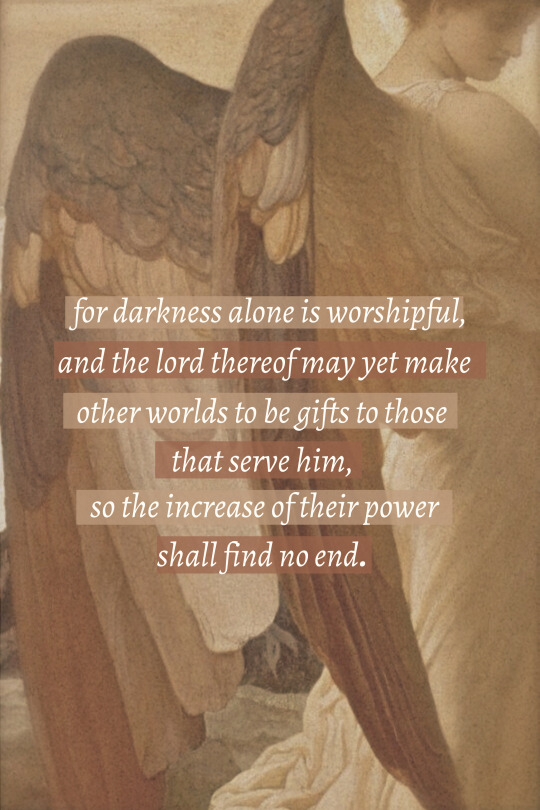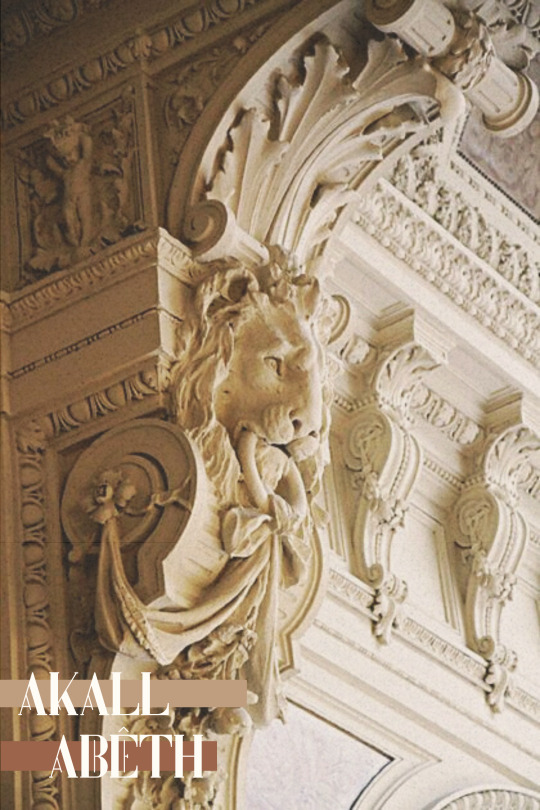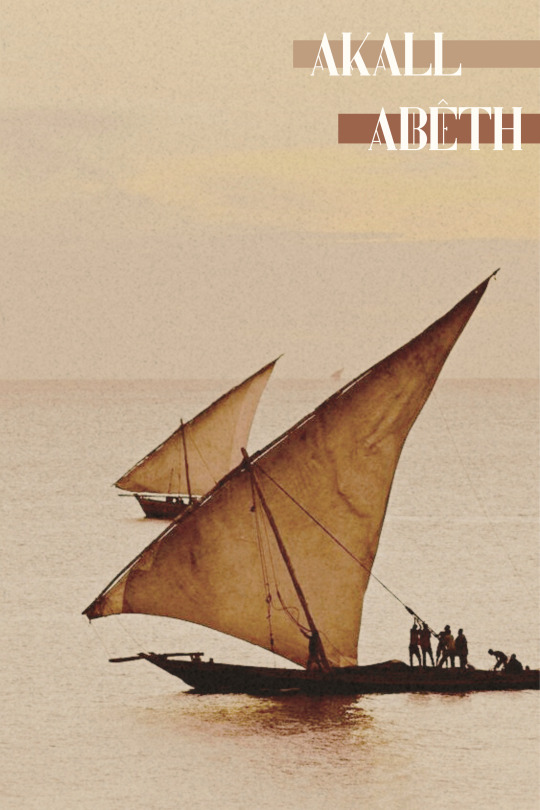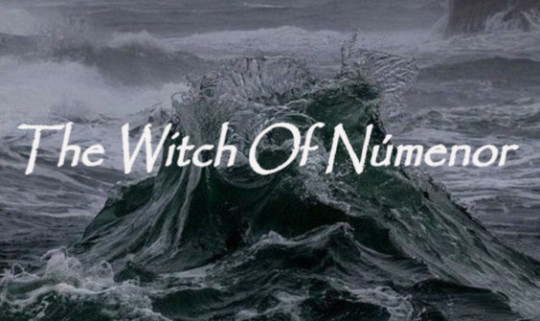#akallabêth
Text

Tar-Míriel and Elendil under the Nimloth tree
Happy new year!
681 notes
·
View notes
Photo








“In an hour unlooked for by Men this doom befell, on the nine and thirtieth day since the passing of the fleets. Then suddenly fire burst forth from the Meneltarma, and there came a mighty wind and a tumult of the earth, and the sky reeled, and the hills slid, and Númenor went down into the sea, with all its children and its wives and its tombs and its riches, and its jewels and its webs and its things painted and carven, and its laughter and its mirth and its music, its wisdom and its lore: they vanished for ever.”
-JRR Tolkien, Akallabêth
[ID: An edit of eight rectangular images in shades of tan, arranged in four rows. 1: A row of carved arches through which a door and part of a courtyard can be seen. White text reading “Akallabêth” (stylized in two rows with backgrounds in two shades of brown) in the top right corner / 2: A woman with braided dark hair wearing a traditional shalwar kameez walking down a staircase, viewed from the back. White text arranged with lines connecting each word in a zigzag pattern reads “the fall of númenor” / 3: A cropped painting of an angel with large wings. Highlighted white text reads “for darkness alone is worshipful, and the lord thereof may yet make other worlds to be gifts to those that serve him, so the increase of their power shall find no end” / 4: A large cornice carved with a lion and other figures. Same text as Image 1, but placed in the bottom left corner / 5: A cloudy sky with forked lightning and the top of a hill visible. Text in the arrangement of Image 2 reads “the age of decadence” / 6: A beach at low tide with large rocks visible far out in the water. Text in the arrangement of Image 3 reads “and ar-pharazôn said: who is the lord of darkness?” / 7: Two small sailboats with people in silhouette floating in the sea. Same text as Image 1 / 8: A gradient of the shades of brown present in the edit with a stylized line drawing of two birds flying over ocean waves. Text reads “exeunt.” //End ID]
#edits#the silmarillion#akallabêth#the professor’s world#described#númenor#brought to you by me#silmedit#tolkienedit#edits with the wild hunt
187 notes
·
View notes
Photo

Tar Mairon in Armenelos
#some colored sketches I did while on vacation#tar mairon#armenelos the golden#armenelos#numenor#Akallabêth#akallabeth#mairon#sauron#sauron in numenor#the silmarillion#silmarillion#The Lord of the Rings#lotr#lotr fanart#silm fanart#fanart#my art
324 notes
·
View notes
Text
Poison
Summary: Mairon on Númenor, on Ar-Pharazôn, and himself.
saintstars inspired me to do a little first person thing for Mairon in Númenor. Entertaining myself on the train while traveling through Europe.
Also posted on AO3 - as always it means the world to me if you click that link as well. <3
My king.
Sometimes in darkest hours, you ask me who I am.
Who I really am. And while you yourself may not, I can hear the trembling in your voice.
You know, and still you ask.
So let me answer.
I am everywhere.
I am the shadow cast onto your land by heavy clouds traveling swiftly on the storm.
I am the putrid seafoam riding the waves that crash onto your shores.
I am the stink of burning flesh coating your isle.
I am the ripple in the water, my king .
I am the poison in the wells.
Find me in every street, find me in every corner.
My roots will grow, crack walls, crack stone.
I am the hand resting on each of your men’s shoulders.
I am the serpent hiding in your sheets.
My words are in your blood and blood is throbbing in your ears.
My king.
My dear king.
I am everywhere.
I am everything.
I am all.
#mairon#sauron#ar-pharazôn#númenor#akallabêth#ficlet#my writing#m writes#the silmarillion#silmarillion#silmarillion fanfiction#silm fanfic#tolkien fanfiction
15 notes
·
View notes
Text
Y’All Should Actually Read Barthes (Or: Why Your ‘Rings Of Power’ Critique Is Bad)

I think what really gets under my skin about the many, many lousy critiques about Rings of Power[1] on Tumblr dot Com and Reddit[2] that I see out there is that, firstly, they frequently seem to come from people who don’t seem to realize that their understanding and memories about Tolkien are shaped far, far, far more by the Peter Jackson movies (which were hardly ‘canon-compliant’) than they are by the original text. Second and more crucially, I think, is that everyone really wants to get pissed about canon that Tolkien never actually codified. Here’s what I mean:
Tolkien didn’t ‘write’ the Silmarillion. He wrote a whole bunch of essays, letters, notes, scraps of ideas, poems, plot outlines, and ramblings, some of which he earmarked for a project he one day planned to compile as something called The Silmarillion.
Then he made a slight error in his scheme by dropping dead.
So his son Christopher Tolkien and his pal Guy Gavriel Kay stared at this enormous pile of stuff that went back decades, pulled out some of the bits they thought were most polished, did their best to link them into some kind of narrative, edited the crap out of it, added punctuation, and published a book they called The Silmarillion after JRR’s planned, but never completed idea.
And was what was in The Silmarillion everything JRR planned to be in the final volume? Not necessarily. In many cases, not remotely, but Christopher Tolkien and Kay tried to take the stuff that was most polished, even if it was thirty year old material that Tolkien had changed his mind fifteen more times on, because the old stuff often had a clarity of completion that the later revisions did not. They usually took the stuff that complete sentences over the stuff with sentence fragments, even if the latter was more ‘fresh.’ Because they realized that The Silmarillion was more a simulacrum of Tolkien’s ideas than anything definitive, Christopher then put out The Unfinished Tales, which contained some more of Tolkien’s ideas: spme that had made it in other versions into The Silmarillion, some that had not. And since the very large pile of notes and scribblings and essays and letters and old recipes didn’t seem any noticeably smaller, he then spent thirteen years publishing The History of Middle Earth, comedically large tomes stuffed to the brim with Tolkien ideas, variations, variants, and late night side-table Kleenex notes. And then they kept putting out more books. And more. And then Christopher made the same silly mistake of dropping dead too! But other people put out even more books, with even more untouched material. There’s a new book coming out in November and JRR Tolkien’s been dead for fifty years!
None of this was published under JRR’s aegis. And let me tell you, JRR Tolkien had a pretty weighty aegis: the man was famous for berating his publishers for edits and corrections. Part of the reason he never got around to completing a definitive Silmarillion was the fact that the man never wanted to publish something with which was not completely satisfied. Everything that has come out after his death, compiled with all the love and care in the world, is nevertheless pretty damning evidence that Tolkien was rarely satisfied.
What we know about old JRR is that he changed his mind again and again, and we can’t know that on his death bed, his last thought wasn’t some brilliant revelation that finally made the One Ring work in the context of Sauron’s timeline in the Second Age. If he did, he didn’t get a chance scribble it on a napkin for his son to later try and make sense of. And so we will never really know what his true canon decision on, say, elven pregnancy was: sometimes he thought it should take about 108 years. Sometimes only 9 years. He would change his mind, or change his math, again and again..
So when you talk about the ‘canon’ of Tolkien, it’s important to remember that even if you’re just speaking about ‘definitive’ works, you’re left with those published with his approval in his lifetime. namely The Hobbit, The Lord of the Rings, The Adventures of Tom Bombadil, and The Road Goes Ever On songbook with Donald Swann. Even with those four books there’s complexity: what version of The Hobbit are you talking about? The original? Or the one he rewrote after he changed his mind about the entire nature of the ring Bilbo found in a cave and decided that actually it was the most important piece of jewelry in existence. Honestly, given world enough and time Tolkien probably would have made a third edition of The Hobbit because those two ‘canonical’ books, The Hobbit and it’s ‘sequel’ Lord of the Rings, don’t even fit together very well, as poor Peter Jackson learned to his sorrow and our pain with his wretched, tonally disjunct Hobbit films.
It’s funny, because everyone on here loves talking about Roland Barthes’ Death of the Author. Almost none of you have ever read it, but it sure is a thing that’s a super important, inviolable concept... until we talk about an author the internet isn’t mad at, and suddenly the author’s word is inviolable and all adaptation choices are wrong.
I don’t know how to get this across any clearer: anyone who has ever dug deep into Tolkien’s lore knows that speaking of things like ‘canon,’ ‘definitive,’ ‘authoritative,’ and all similar adjectives is often a fool’s errand. Tolkien left us with a lot of ideas about the second age, but very little in the way of clarity, much less ‘this is the true thing unchanging.’ Even the ‘authoritative’ timeline of the Appendices in LOTR is stuff he was changed in the writings he did in the years after.
So I am begging you. Please. Please stop giving the Akallabêth a level of authoritative definition that even its compiler admitted it did not possess. Until you can prove to me you brought the shade of JRR Tolkien back from beyond the Veil to speak True Authorial Intent,[3] I am going to treat your recourse to ‘but the canon’ with the level of exasperation it deserves.
--------------------------
[1] Besides the general problem on this website that everyone’s heard of critical theory and almost nobody’s ever read any.
[2] There are plenty of valid critiques to be made, especially about pacing and awkward racial optics, but it’s really not the unhinged shit I’m seeing, as usual.
[3] Let’s be honest: in the fifty years since he shuffled off his mortal coil, the shade of Tolkien will unquestionably return with a ghostly second pile of essays, letters, notes, scraps of ideas, poems, plot outlines, and ramblings, and they won’t be remotely definitive either.
And we’re all going to be super disgruntled when the ghost insists that the only good adaptation is his work is Khraniteli.
#rings of power#tolkien#jrr tolkien#The Hobbit#The Lord of The Rings#Akallabêth#Christopher Tolkien#the silmarillion#Guy Gavriel Kay#rop#LOTR#Khraniteli#Barthes#Peter Jackson
350 notes
·
View notes
Text
Dear Annatar, dear Celebrimbor,
I'm sorry I mocked your eyebrows repeatedly. At least none of you shaved and then put a towel on your head to make up for it. You only went too strong on the epilation.
Regards,
Me


Seems like I can't fully avoid Jeff Pesos' fanfiction: the towel au...
#I remember the 2000s and the thin brows#i was there gandalf#shadow of mordor#shadow of war#celebrimbor#sauron#annatar#tyelperinquar#tyelpë#akallabêth#silmarillion#the lord of the rings#lotr#jeff pesos fanfiction#the towel au
201 notes
·
View notes
Text
Interesting irony in that the Edain of the First Age have a tradition that they were originally meant to be immortal too, but lost their immortality due to the machinations of Melkor. Then you have their descendants, the Dúnedain of Númenor, who end up worshipping Melkor in an attempt to attain immortality.
166 notes
·
View notes
Text
“Hope rather that in the end even the least of your desires shall have fruit. The love of Arda was set in your hearts by Ilúvatar, and he does not plant to no purpose.”
— The Silmarillion
85 notes
·
View notes
Text
1.4k words, Gen
No Archive Warnings Apply
Fandom: The Silmarillion and other histories of Middle-Earth - J. R. R. Tolkien
Characters: Original characters
Summary:
A Númenorean family in early Gondor discusses accounts of the fall.
#silmarillion#númenor#gondor#akallabêth#fair warning I'm going to reblog this post a couple of times next few days#i wrote most of this and then thought I'd do better to write from a servant's perspective#but by then... i had become too fond of what i already had#my ocs are mostly flashes of scenes but these grew up a lot in my mind somehow#my fic
14 notes
·
View notes
Text
The Witch Of Númenor


Míriel went by many titles when she was alive.
But her favorite title was one that was given to her after she was dead, one that stove terror in the hearts of men across Middle Earth, Terrorized kings in their jeweled cities. The shadow in the east, Weapon of horror, Lord of Nazguls.
The Witch-King of Angmar.
She was one of the nine, the chief of them all, second hand to Sauron, and ever loved and hated her master. She was Captain of Minas Morgul and the vale, master of beasts. All would fear her and dread the shadow of the Witch-King.
And no man would slay thee
Read More Here
37 notes
·
View notes
Text
actually I do want to make a Númenor playlist about living in a decaying empire and feeling the slow turn of fate against you and wondering if your deity thinks you’re a good person
that’s like. the heart and soul of the last days of Anadûnê right there.
#tolkien#akallabeth#akallabêth#silmarillion#maybe I’m obsessed with Tar-Míriel and Elendil and their tempestuous relationships with Eru#what about it
39 notes
·
View notes
Text
imagine Amandil in Romenna reading his official dismissal from the court of Númenor, he rolls open the massive scroll and all it says is dismissal for the reason of, quote "was homophobic to Sauron" -Sauron
turning to his son and grandsons like alright boys i think it's time i crash my boat into a rock like they used to do in the good old days
#rowan screams into the void#it reads like a twitter callout post#i think its safe to say sauron would run the country like that#akallabêth
5 notes
·
View notes
Text
Summary: Ar-Pharazôn stumbles upon a new type of ritual being performed in the Temple of Melkor.
Not beta'd since it's a rather quick thing I whipped out during a train ride and breakfast and which I originally planned to be even shorter.
Thanks to @cilil for confirming there's def some sex cult rituals happening in the Temple of Melkor lol
#mairon#sauron#ar-pharazôn#mairon x ar-pharazôn#númenor#akallabêth#the silmarillion#silmarillion#silmarillion fanfiction#silm fanfic#ficlet#tolkien fanfiction#my writing#m writes
8 notes
·
View notes
Text
I love the Númenóreans for a lot of reasons (peak problematic faves!), but a big one is how much they love the Edain.
#anghraine babbles#legendarium blogging#'we also are daughters of the great' is about living up to the legacy of the edain#númenóreans in gondor still name their kids húrin or morwen#not only do they not forget what they come from they think it's fantastic#elrond pretty evidently can't think of greater praise than comparisons to beren and túrin#(yes he counts as númenórean for these purposes)#i'm really fond of edain and every time i see a thing about how the silm is about elves behaving badly#part of my mind is like 'uhhhh what about the edain'#beren and narn and akallabêth erasure!!! and plenty of other things too!#so it is nice that in-story my fave people are like 'the edain were important and awesome actually'#legendarium fanwank#team edain#team dúnedain
50 notes
·
View notes
Text
Comparative Studies, or Twice on the Verge of Falling
The Rimôn fresco of Elwing is considered to be one of the greatest artworks of the Late Classical Era. Found in the courtyard of the old Helcaril Villa (itself a marvellous example of architectural trends during the reign of Tar-Elendil), it occupies a relatively modestly-sized, but excellently exposed niche across from the entrance. Aside from the considerable fame the artist had later gathered, it remains remarkable both for its vividness of emotional expression, contrasting to the usual art style of the era, and for the number and fame of its copies.
The best known of these is the one gracing the lesser courtyard of the villa Surë-or-Falmar. Indeed, the glory of the two is so closely interwined that it seems impossible to ascertain which had contributed to the fame of the other more. And yet the effect of the copy wildly differs from that of the original artwork.
The Rimôn Fresco depicts the figure of the young Elwing standing on the cliff with her back to the churning waters below. She is poised halfway toward the drop, as if on the verge of throwing herself in, one hand clasping the Silmaril at her neck. Wind whips at her torn dress and loose hair. A rarity among artworks confronting the subject, it depicts neither the enemy she is facing, nor the the transformation into bird itself. The figure stands alone - and seems strikingly young. Beholders oft remark that it is hard to believe she is meant to depict a wife and a mother.
The wild and violent atmosphere of the fresco, even though, as with most Classical works, it depicts no blood, and despite the aforementioned lack of actual fighting shown, made its artistic quality fall under scrutiny in its day. From diaries, journals and letters of the period we can, however, see that it proved intriguing enough that people would come visit the Helcaril Villa only to see it in person - and that it won over many of those who were originally critical. Thus it is difficult to ascertain whether the changed nature of the Surë-or-Falmar villa Fresco was intentional on the part of the copyist, or the sign of an inexperienced hand.
The name of the copy's painter has unfortunately escaped history. The style is typical to the reign of Tar-Meneldur, though an exemplary of its genre rather than a dull attempt at imitating fashion. The colour combinations are soft, slightly more so than in the Rimôn Fresco, the lines clean, and the light hazy. The figure depicted is in the exact same position as that in the original artwork.
Viewers of both frescoes predominantly agree, however, that despite the technical skill the painter has exhibited, the Surë-or-Falmar Fresco lacks something of Rimôn's Elwing. The posture is just a little less dynamic; the cliff's edge (perhaps unconsciously or accidentally) removed slightly father from Elwing's feet, making her situation seem something less desparate. The wind's effects hardly seem those of a real gale, and more an aesthetic choice. One of the most interesting judgements has been pronounced by Herunimon of Eldalondë in a letter to his cousin, Rilendur, son of Verahil, dated 24th Nárië, 901: "The S.o.F. figure seems less the Lady Elwing fenced in by foes and making a tragic choice, but more the heroine of one of those new romances, unsure whether to flee the scene after a man has confessed his love to her, or to accept his proposal - or, I hardly know, perhaps such heroines lead more exciting lives than I would guess (...) - but anyhow, the fresco seems more like a coloured plate in a rich novel, than a mural depcting a tale of the Elder Days. All in all, there is not one element which does not fit. But taken together, the effect is incongruous." (Collected Letters, volume II, as accessed from the Royal Library in Romenna)
(from the Romenna Journal of Artistic and Literary Studies)
***
Editor's note: Remembering the considerable public outcry after the publication of Songs of the Elder Days: Lyrics, History and Analysis, the University of Romenna along with its subsidiary organisations seek to make it understood that the views of authors, as regards the addition or not of Lord and Lady before the names of Lord Eärendil and Lady Elwing, do not necessarily represent its own. Were the University to be flippant, it might also seek to ask why proper respect being accorded to the Lord and Lady seems to be held in greater importance than that it be accorded to the Valar, but the University understands that this would bring on public outcry against it from people on both sides of the moro-political divide, so it shall keep its silence.
#A.k.a. adventures in drawing - when your sketch has more life in it than the clean copy.#I imagine this to belong to the later#but not yet Akallabêth-adjacent era of Númenor.#The era of exploration and friendly interchange is slowly giving way to imperialism#the divides are beginning to become semi-entrenched in society#and the fear of mortality is there --#but it has not begun to consume every waking thought of the people suffering it#it is not illegal to hold to the old ways#and elves are still admired by many.#Surë-or-Falmar should translate to “Wind-over-Waves”#though I cannot be sure I did it correctly.#Rimôn is a name invented by me#supposed to sound at least a bit Adunaic; the other names are meant to be Quenya.#my post#Númenor#Elwing#tolkien#Silmarillion#silm#in universe texts#peoples of arda#in universe documents#in-universe meta#in-universe academia#fictional academia
7 notes
·
View notes
Text
Maybe the real reason sauron hated aragorn was because he plagiarised his halbrand look
#the whole scruffy king in exile thing??#and the whole thing with an elven lady? yeah he did that first#and hes just bitter bc he lost his hot form in akallabêth#halbrand
22 notes
·
View notes